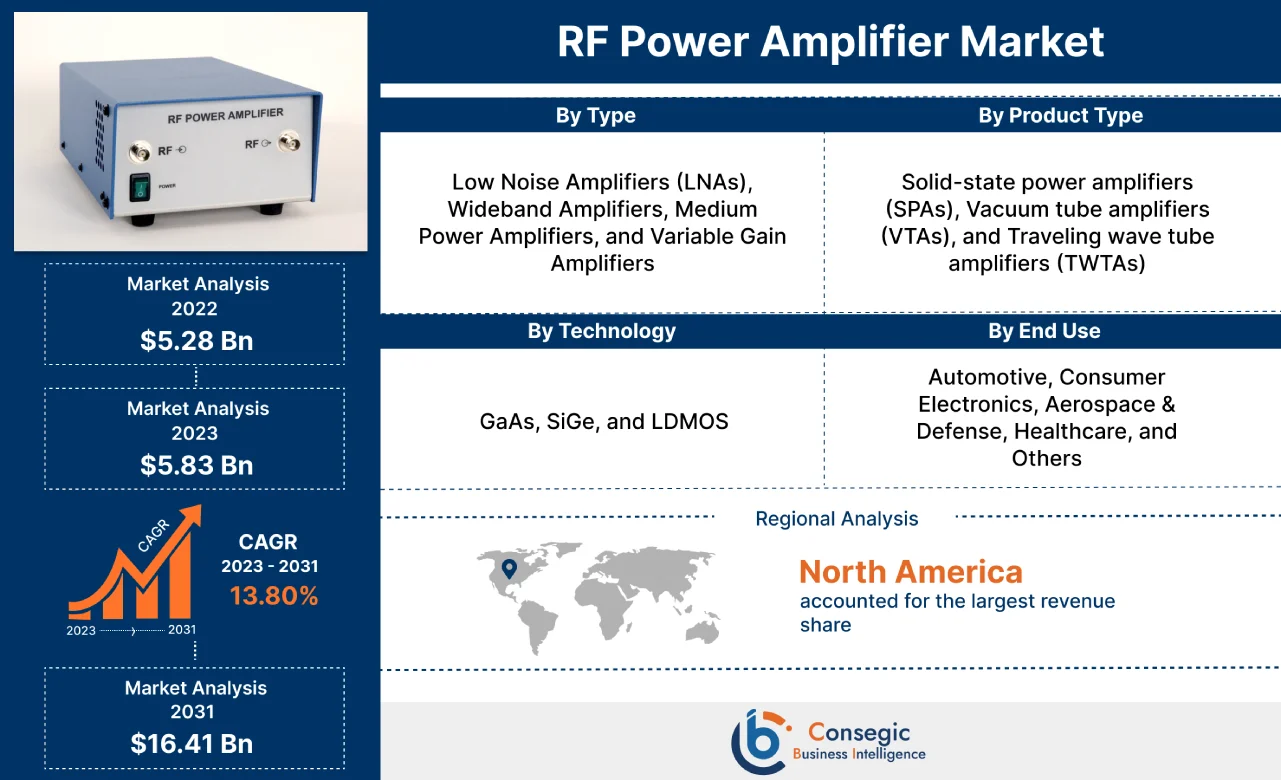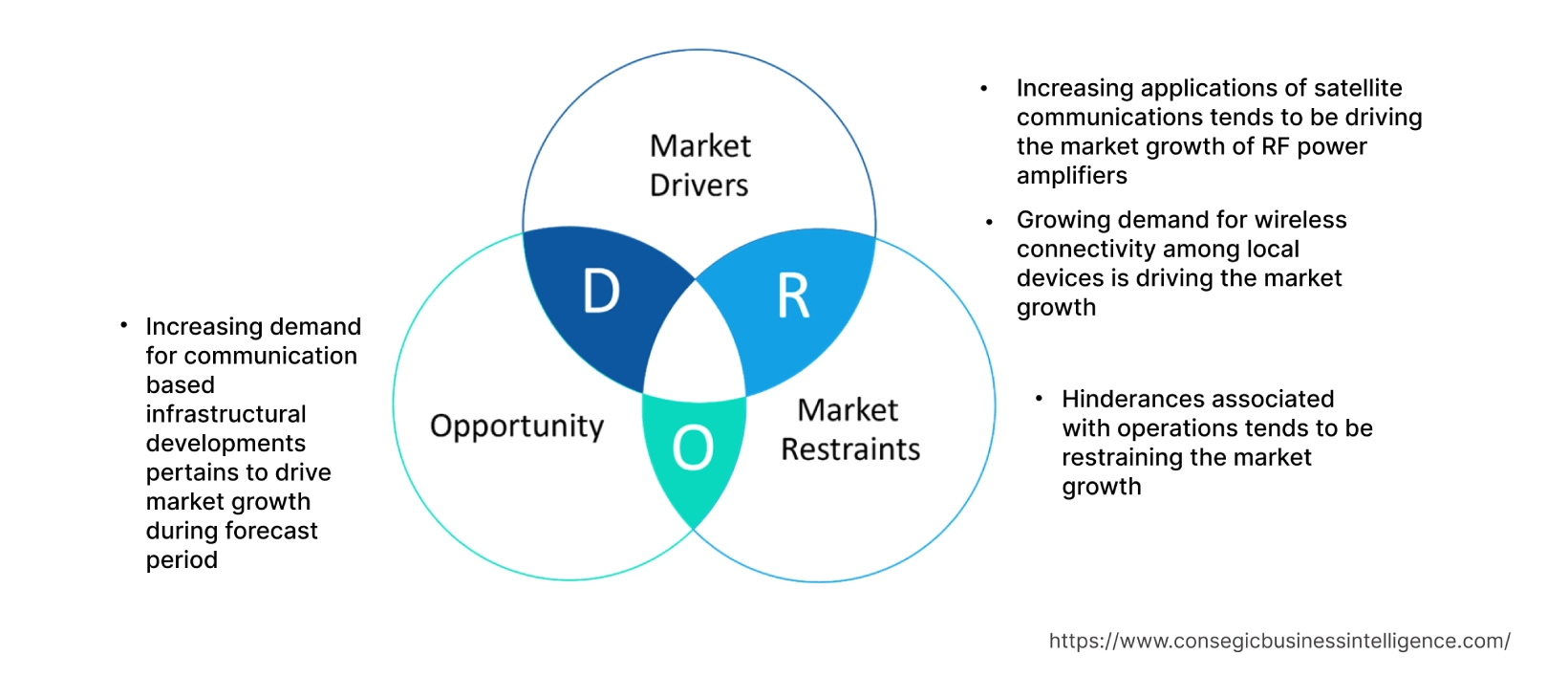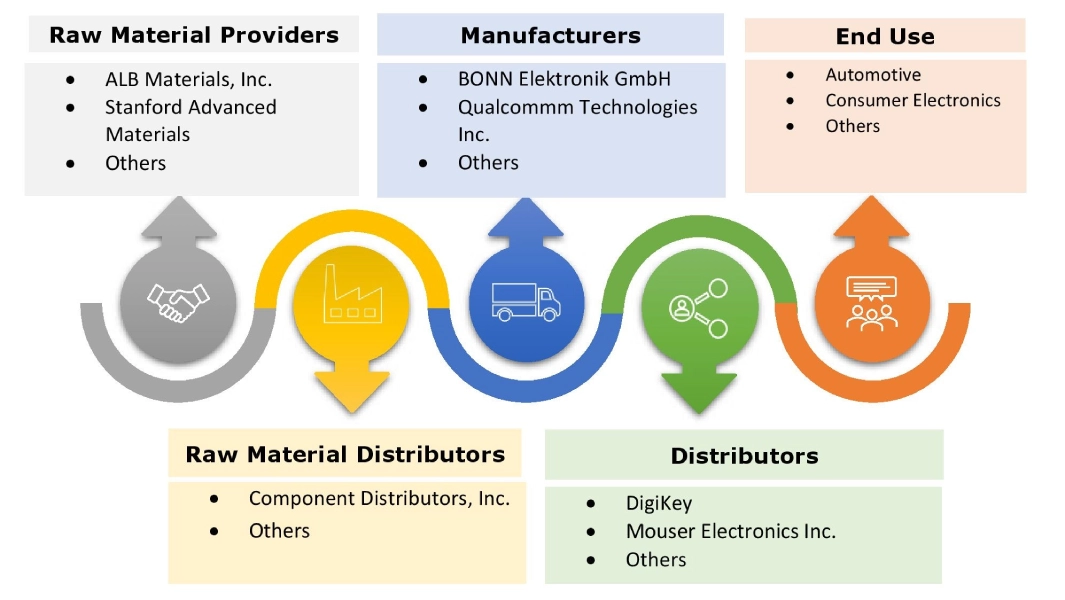RF Power Amplifier Market Scope & Overview:
RF Power Amplifier Market size is estimated to reach over USD 18.27 Billion by 2032 from a value of USD 6.51 Billion in 2024 and is projected to grow by USD 7.29 Billion in 2025, growing at a CAGR of 13.8% from 2025 to 2032.
RF Power Amplifier Market Size :
RF power amplifier (PA) is an electrical circuit that converts low power radio frequency signals into high power radio frequency signals. RF PAs boost the power of RF signals, which are electromagnetic waves used in various applications like broadcasting, cellular communication, and radar. They are crucial in transmitters, where they amplify the signal before it is radiated by an antenna. The benefits of RF PAs include maximizing gain, power output, and efficiency while minimizing distortion and ensuring good impedance matching.
RF Power Amplifier Market Insights :
RF Power Amplifier Market Dynamics - (DRO) :
Key Drivers :
Rising adoption of RF power amplifiers in healthcare is boosting the market.
RF power amplifiers play a crucial role in various medical applications, including imaging, diagnostics, and therapeutic treatments. These amplifiers boost the power of radio frequency signals, enabling detailed imaging in MRI (magnetic resonance imaging), targeting cancer cells in RF ablation, and developing new diagnostic tools. RF amplifiers are essential for generating the radio waves that create detailed images of internal organs and tissues. Radiofrequency ablation uses RF energy to destroy cancerous tissue, and RF amplifiers are crucial for delivering the necessary power. Addtitionally, RF energy is also used in certain cosmetic treatments to stimulate collagen production and improve skin texture.
- For instance, GE Healthcare offers 1.5T RF amplifier power module in its product offerings. The module is used in magnetic resonance imaging.
Thus, the aforementioned factors are boosting the adoption of these amplifiers, in turn driving the RF power amplifier market growth.
Key Restraints :
Technical issues associated with RF power amplifiers are hindering the market growth
RF power amplifier issues can originate from a variety of factors, including overheating, interference, and design flaws. Common issues include device failure due to poor grounding, thermal fatigue, or excessive heat. Additionally, amplifiers struggle with maintaining linearity, leading to signal distortion and interference, or have efficiency limitations. Thus, the market analysis shows that the aforementioned factors are restraining the RF power amplifier market demand.
Future Opportunities :
Increasing demand for communication-based infrastructural developments is creating new market opportunities
RF power amplifiers are crucial for communication-based infrastructural developments, particularly in wireless technologies like 4G, 5G, and beyond. They amplify radio frequency signals, ensuring reliable transmission over long distances and enabling faster, more efficient wireless communication. These amplifiers are essential for building and maintaining telecommunication networks, including 5G infrastructure, and are also used in various other wireless applications like satellite communication, Bluetooth, Wi-Fi, and radar systems.
Thus, the rising developments in communication-based infrastructural developments are projected to drive RF power amplifier market opportunities during the forecast period.
RF Power Amplifier Market Segmental Analysis :
By Type :
Based on the type, the market is segmented into low noise amplifiers (LNAs), wideband amplifiers, medium power amplifiers, and variable gain amplifiers.
Trends in the Type:
- Rising adoption of variable gain amplifiers to provide flexibility in signal processing is boosting the RF power amplifier market size.
- Increasing trend in adoption of medium power amplifiers to offer high efficiency with low distortion is driving the market growth.
The wideband amplifiers segment accounted for the largest revenue share in the RF power amplifier market share in 2024.
- RF wideband amplifiers, also known as broadband amplifiers, are electronic devices that amplify radio frequency signals across a broad range of frequencies.
- They are essential for applications requiring a single amplifier to handle multiple radio frequencies or where a wide frequency range is necessary, such as in defense, radar, telecom, and test instrumentation.
- RF wideband amplifiers amplify signals across a broader spectrum of frequencies as compared to traditional, narrow-band amplifiers.
- They offer a single amplifier to handle multiple frequency bands, simplifying system design.
- Many wideband amplifiers are designed for high gain, amplifying signals effectively while minimizing the introduction of noise, crucial for applications like signal reception.
- Therefore, the aforementioned factors are boosting the RF power amplifier market growth.
The low noise amplifiers (LNAs) segment is expected to register the fastest CAGR during the forecast period.
- A low-noise amplifier (LNA) is an electronic device designed to amplify weak signals while minimizing the introduction of additional noise.
- It is a critical component in radio receivers and other systems where capturing faint signals is essential, ensuring that the amplified signal is not degraded by excessive noise.
- LNAs boost the power of a low-level signal, making it strong enough for further processing.
- The primary goal of an LNA is to amplify the signal without introducing significant noise, which would degrade the signal-to-noise ratio (SNR).
- The performance of an LNA directly affects the receiver's sensitivity, as a low-noise LNA enables the detection of weaker signals.
- Thus, the market trends analysis shows that the aforementioned factors are expected to boost the RF power amplifier market trends during the forecast period.
By Product Type :
Based on the product type, the market is segmented into solid-state power amplifiers (SSPAs), vacuum tube amplifiers (VTAs), and traveling wave tube amplifiers (TWTAs).
Trends in the Product Type:
- Rising adoption of traveling wave tube amplifiers due to benefits including high power, high efficiency, and wide bandwidth capabilities is boosting the RF power amplifier market size.
- Increasing adoption of vacuum tube amplifiers (VTAs) for benefits including lower power consumption and higher efficiency is boosting the market growth.
The solid-state power amplifiers (SSPAs) segment accounted for the largest revenue share in the market in 2024, and it is also expected to register the fastest CAGR during the forecast period.
- A solid-state power amplifier (SSPA) is an electronic device that amplifies radio frequency signals using solid-state components like transistors.
- SSPAs are used in various applications, including satellite earth stations, cellular networking, and broadcasting systems. They offer advantages such as high efficiency and power levels.
- SSPAs are designed to be highly efficient, converting a significant portion of the input power into amplified output power.
- SSPAs, particularly those using GaN or GaAs technology, are known for their reliability and ability to withstand high power levels and high frequencies.
- SSPAs are designed to operate over a wide range of frequencies, making them suitable for various communication systems.
- Thus, the market analysis depicts that the aforementioned factors are expected to boost the RF power amplifier market trends during the forecast period.
By Technology :
Based on the technology, the market is segmented into GaAs, SiGe, and LDMOS.
Trends in the Technology:
- Rising adoption of SiGe power amplifiers due to benefits including high-power output, good efficiency, and excellent linearity is driving the market growth.
- Increasing adoption of LDMOS power amplifiers, due to their ability to handle large power levels and enhance efficiency.
The GaAs segment accounted for the largest revenue in the RF power amplifier market share in 2024.
- GaAs (Gallium Arsenide) power amplifiers are semiconductor devices that amplify radio frequency signals.
- They are known for their high efficiency, linearity, and ability to operate at high frequencies. These amplifiers are widely used in wireless communication, radar, and satellite systems.
- GaAs devices operate at frequencies up to 250 GHz, making them suitable for high-frequency communication and radar applications.
- Moreover, GaAs power amplifiers offer high efficiency, which enables them to convert a larger portion of input power into output power, thereby reducing energy consumption.
- GaAs amplifiers tend to be more linear than GaN amplifiers, resulting in less distortion and better signal quality.
- Therefore, the market analysis shows that the aforementioned factors are boosting the RF power amplifier market demand.
The LDMOS segment is expected to register the fastest CAGR during the forecast period.
- LDMOS (Laterally Diffused Metal-Oxide Semiconductor) transistors are a dominant technology for high-power RF PA used in various applications like base stations, broadcast transmitters, and industrial power systems.
- They are known for their ability to handle large power levels and high efficiency, making them suitable for demanding RF applications.
- LDMOS amplifiers can handle large power levels due to their superior power handling capability, which is attributed to their higher breakdown voltage and better thermal performance.
- LDMOS devices offer high efficiency, making them suitable for applications where power consumption needs to be minimized.
- Thus, the aforementioned factors are expected to boost the RF power amplifier market opportunities during the forecast period.
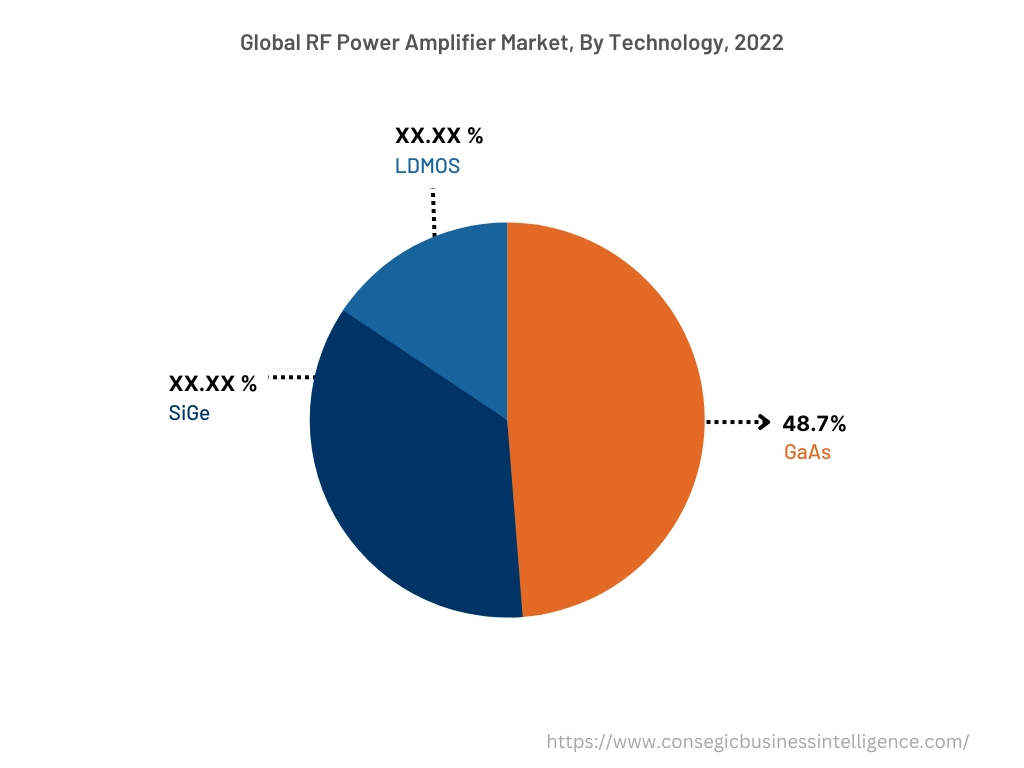
By End-Use :
Based on the end use, the market is segmented into automotive, consumer electronics, aerospace and defense, healthcare, and others.
Trends in the End Use:
- Rising adoption of power amplifiers in healthcare due to applications including diagnostic imaging, cancer treatment, and emerging diagnostic tools.
- Increasing demand for power amplifiers in aerospace and defense due to benefits including increased range, improved signal quality, enhanced reliability, and others is boosting the market growth.
The automotive segment accounted for the largest revenue share of 34.80% in the market in 2024.
- RF power amplifiers are crucial in automotive systems, particularly for applications like radar, wireless communication (including cellular and satellite), and sensor systems.
- They enable vehicles to communicate with each other, with infrastructure, and with the outside world.
- They are essential for transmitting and receiving data in wireless communication systems, including cellular networks, satellite communication, and in-vehicle communication systems.
- They ensure reliable connectivity and data transmission for various vehicle functions, such as infotainment, navigation, and over-the-air software updates.
- Therefore, the market analysis depicts that the aforementioned factors are boosting the RF power amplifier market expansion.
The consumer electronics segment is expected to register the fastest CAGR during the forecast period.
- RF power amplifiers are crucial components in consumer electronics, boosting the power of radio frequency signals for various applications like wireless communication, broadcasting, and IoT devices.
- They are essential for transmitting signals effectively in devices like smartphones, laptops, and other electronic gadgets.
- Moreover, RF amplifiers are used in radio and television broadcasting to amplify the signals for long-range transmission.
- In Internet of Things (IoT), RF amplifiers play a crucial role in connecting and managing a vast array of smart devices.
- Thus, the aforementioned factors are expected to boost the RF power amplifier market expansion during the forecast period.
By Region :
The regions covered are North America, Europe, Asia Pacific, the Middle East and Africa, and Latin America.
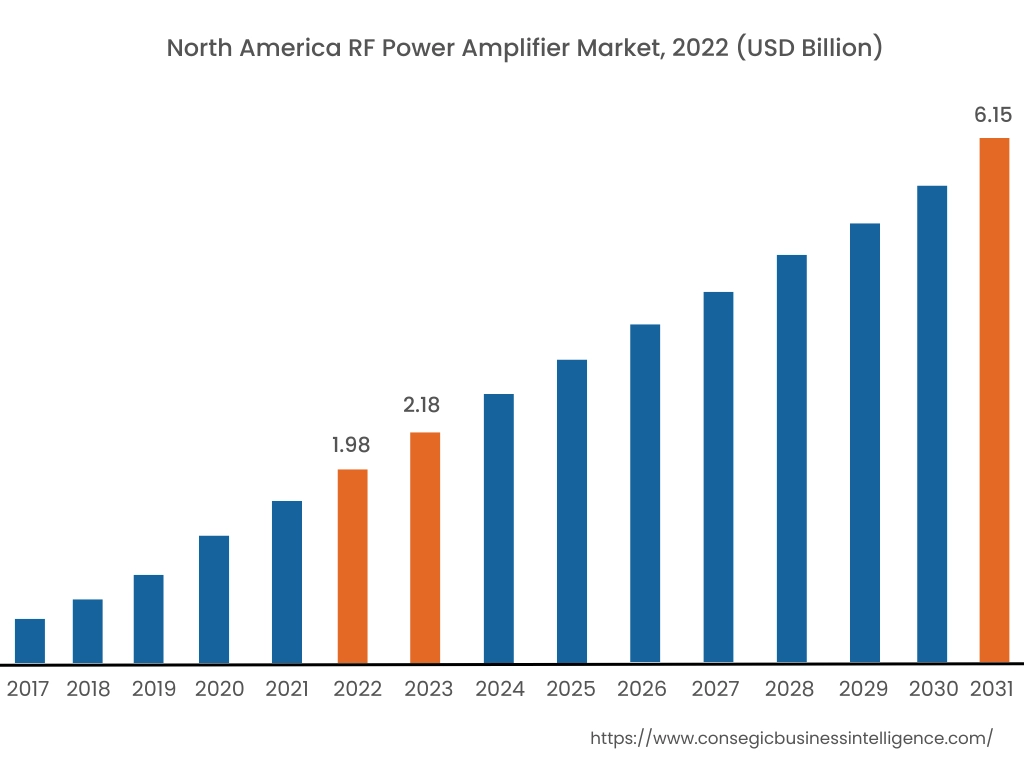
Asia Pacific region was valued at USD 1.92 Billion in 2024. Moreover, it is projected to grow by USD 2.15 Billion in 2025 and reach over USD 5.56 Billion by 2032. Out of this, China accounted for the maximum revenue share of 34.60%. As per the RF power amplifier market analysis, the expanding consumer electronics and automotive sectors in the region are driving the adoption of power amplifiers.
- For instance, according to the India Brand Equity Foundation, automobiles sold in India in FY 2024 reached 23.9 million. This indicates the rising demand for RD power amplifiers from the automotive industry in the Asia-Pacific region.
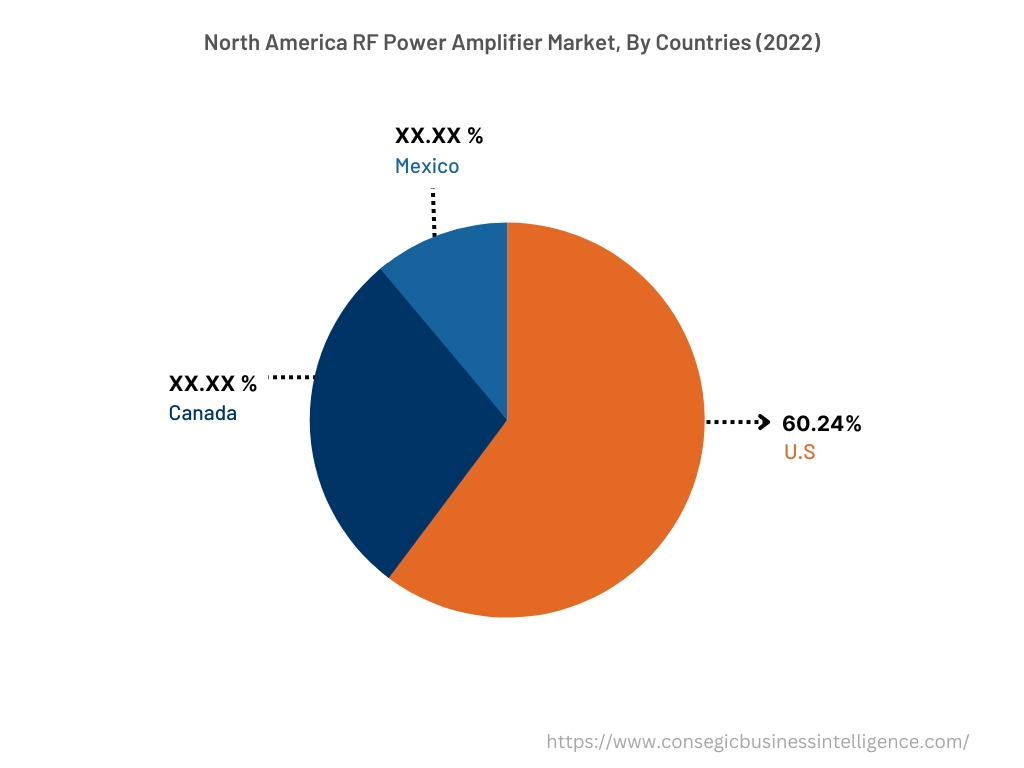
North America is estimated to reach over USD 5.92 Billion by 2032 from a value of USD 2.16 Billion in 2024 and is projected to grow by USD 2.42 Billion in 2025. The market in the region is primarily growing due to well-established aerospace and defense industry that uses RF PAs for communication, radar systems, electronic warfare, and others.
Additionally, the RF power amplifier market analysis in Europe shows that the market is growing due to rising healthcare sector that requires power amplifiers for radiofrequency ablation, diagnostics tools, wireless medical sensors, and others. In Latin America, the Middle East and Africa, the market is primarily growing due to rising penetration of consumer electronics, leading to growing demand for power amplifiers for various applications including communication, transmission, and others.
Top Key Players & Market Share Insights:
The RF power amplifier industry is highly competitive with major players providing solutions and services to the national and international markets. Key players are adopting several strategies in research and development (R&D), product innovation, and end-user launches to hold a strong position in the global RF power amplifier market. Key players in the RF power amplifier industry include -
- Toshiba Corporation (Japan)
- BONN Elektronik GmbH (Germany)
- Ametek (US)
- Mitsubishi Electric Corporation (Japan)
- Kratos Defense & Security Solutions, Inc. (US)
- Qualcommm Technologies Inc. (US)
- Qorvo Inc. (US)
- CPI International Inc. (US)
- Advantech Wireless Technologies Inc. (Canada)
- Infineon Technologies AG (Germany)
RF Power Amplifier Market Report Insights :
| Report Attributes | Report Details |
| Study Timeline | 2019-2032 |
| Market Size in 2032 | USD 18.27 Billion |
| CAGR (2025-2032) | 13.8% |
| By Type |
|
| By Product Type |
|
| By Technology |
|
| By End Use |
|
| By Region | North America, Europe, Asia-Pacific, Latin America, and Middle East & Africa |
| Key Players |
|
Key Questions Answered in the Report
How big is the RF power amplifier market? +
RF Power Amplifier Market size is estimated to reach over USD 18.27 Billion by 2032 from a value of USD 6.51 Billion in 2024 and is projected to grow by USD 7.29 Billion in 2025, growing at a CAGR of 13.8% from 2025 to 2032.
What are the major segments covered in the RF power amplifier market report? +
The segments covered in the report are type, product type, technology, end use, and others.
Which region holds the largest revenue share in 2024 in the RF power amplifier market? +
North America holds the largest revenue share in the RF power amplifier market in 2024.
Who are the major key players in the RF power amplifier market? +
The major key players in the market are Toshiba Corporation (Japan), BONN Elektronik GmbH (Germany), Qualcommm Technologies Inc. (US), Qorvo Inc. (US), CPI International Inc. (US), Advantech Wireless Technologies Inc. (Canada), Infineon Technologies AG (Germany), Ametek (US), Mitsubishi Electric Corporation (Japan), and Kratos Defense & Security Solutions, Inc. (US).
